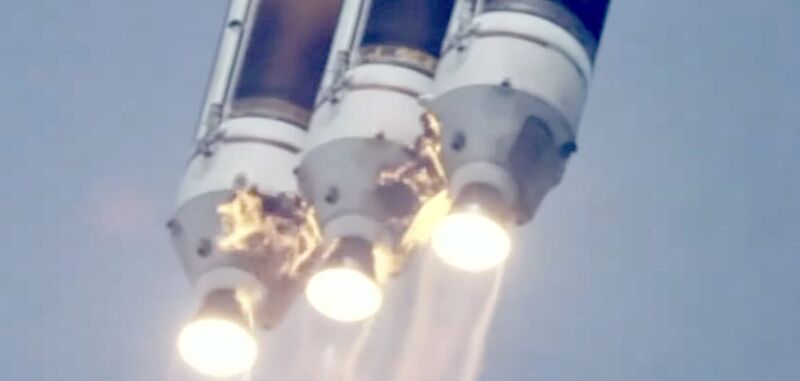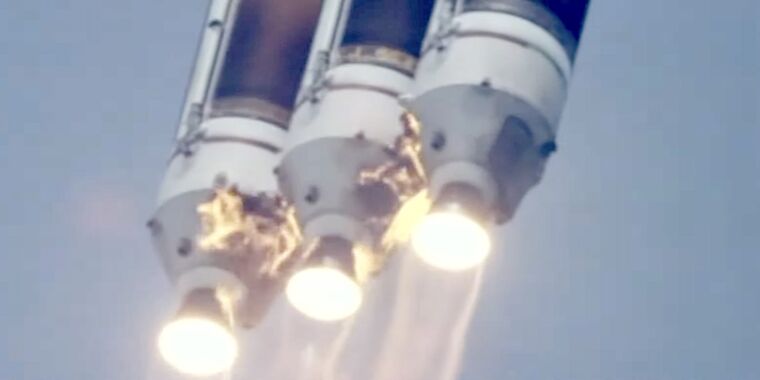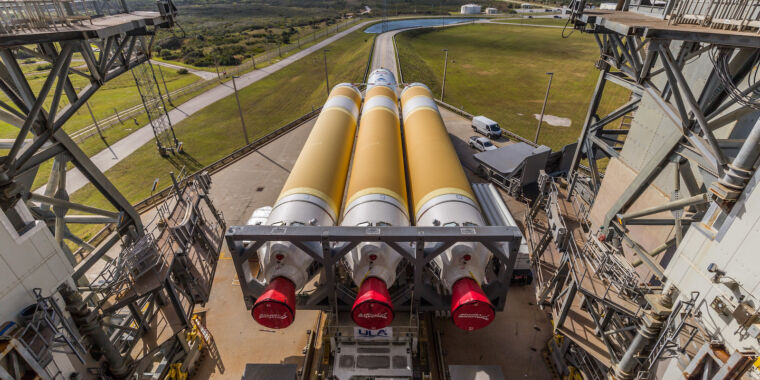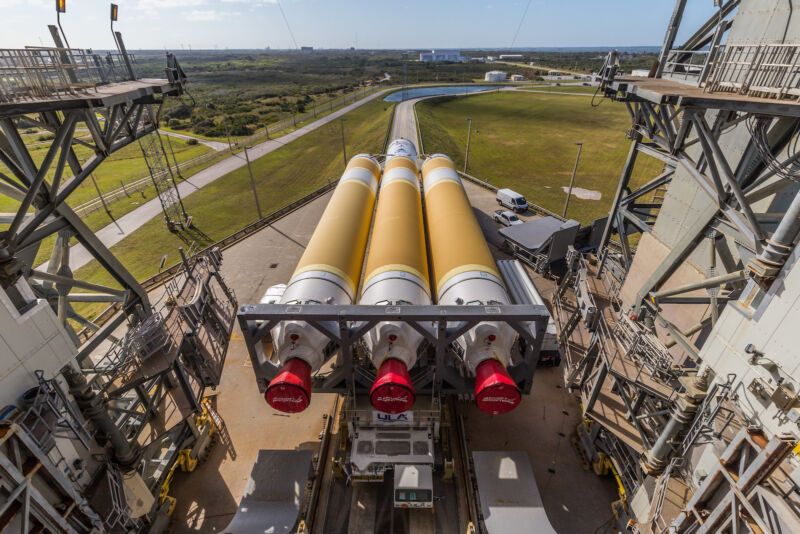After a fiery finale, the Delta rocket family now belongs to history
Delta 389 —
“It is bittersweet to see the last one, but there are great things ahead.”

Enlarge / In this video frame from ULA’s live broadcast, three RS-68A engines power the Delta IV Heavy rocket into the sky over Cape Canaveral, Florida.
United Launch Alliance
The final flight of United Launch Alliance’s Delta IV Heavy rocket took off Tuesday from Cape Canaveral, Florida, with a classified spy satellite for the National Reconnaissance Office.
The Delta IV Heavy, one of the world’s most powerful rockets, launched for the 16th and final time Tuesday. It was the 45th and last flight of a Delta IV launcher and the final rocket named Delta to ever launch, ending a string of 389 missions dating back to 1960.
United Launch Alliance (ULA) tried to launch this rocket on March 28 but aborted the countdown about four minutes prior to liftoff due to trouble with nitrogen pumps at an off-site facility at Cape Canaveral. The nitrogen is necessary for purging parts inside the Delta IV rocket before launch, reducing the risk of a fire or explosion during the countdown.
The pumps, operated by Air Liquide, are part of a network that distributes nitrogen to different launch pads at the Florida spaceport. The nitrogen network has caused problems before, most notably during the first launch campaign for NASA’s Space Launch System rocket in 2022. Air Liquide did not respond to questions from Ars.
A flawless liftoff
With a solution in place, ULA gave the go-ahead for another launch attempt Tuesday. After a smooth countdown, the final Delta IV Heavy lifted off from Cape Canaveral Space Force Station at 12: 53 pm EDT (16: 53 UTC).
Three hydrogen-fueled RS-68A engines made by Aerojet Rocketdyne flashed to life in the final seconds before launch and throttled up to produce more than 2 million pounds of thrust. The ignition sequence was accompanied by a dramatic hydrogen fireball, a hallmark of Delta IV Heavy launches, that singed the bottom of the 235-foot-tall (71.6-meter) rocket, turning a patch of its orange insulation black. Then, 12 hold-down bolts fired and freed the Delta IV Heavy for its climb into space with a top-secret payload for the US government’s spy satellite agency.
Heading east from Florida’s Space Coast, the Delta IV Heavy appeared to perform well in the early phases of its mission. After fading from view from ground-based cameras, the rocket’s two liquid-fueled side boosters jettisoned around four minutes into the flight, a moment captured by onboard video cameras. The core stage engine increased power to fire for a couple more minutes. Nearly six minutes after liftoff, the core stage was released, and the Delta IV upper stage took over for a series of burns with its RL10 engine.
At that point, ULA cut the public video and audio feeds from the launch control center, and the mission flew into a news blackout. The final portions of rocket launches carrying National Reconnaissance Office (NRO) satellites are usually performed in secret.
In all likelihood, the Delta IV Heavy’s upper stage was expected to fire its engine at least three times to place the classified NRO satellite into a circular geostationary orbit more than 22,000 miles (nearly 36,000 kilometers) over the equator. In this orbit, the spacecraft will move in lock-step with the planet’s rotation, giving the NRO’s newest spy satellite constant coverage over a portion of the Earth.
It will take about six hours for the rocket’s upper stage to deploy its payload into this high-altitude orbit and only then will ULA and the NRO declare the launch a success.
Eavesdropping from space
While the payload is classified, experts can glean a few insights from the circumstances of its launch. Only the largest NRO spy satellites require a launch on a Delta IV Heavy, and the payload on this mission is “almost certainly” a type of satellite known publicly as an “Advanced Orion” or “Mentor” spacecraft, according to Marco Langbroek, an expert Dutch satellite tracker.
The Advanced Orion satellites require the combination of the Delta IV Heavy rocket’s lift capability, long-duration upper stage, and huge, 65-foot-long (19.8-meter) trisector payload fairing, the largest payload enclosure of any operational rocket. In 2010, Bruce Carlson, then-director of the NRO, referred to the Advanced Orion platform as the “largest satellite in the world.”
When viewed from Earth, these satellites shine with the brightness of an eighth-magnitude star, making them easily visible with small binoculars despite their distant orbits, according to Ted Molczan, a skywatcher who tracks satellite activity.
“The satellites feature a very large parabolic unfoldable mesh antenna, with estimates of the size of this antenna ranging from 20 to 100 (!) meters,” Langbroek writes on his website, citing information leaked by Edward Snowden.
The purpose of these Advanced Orion satellites, each with mesh antennas that unfurl to a diameter of up to 330 feet (100 meters), is to listen in on communications and radio transmissions from US adversaries, and perhaps allies. Six previous Delta IV Heavy missions also likely launched Advanced Orion or Mentor satellites, giving the NRO a global web of listening posts parked high above the planet.
With the last Delta IV Heavy off the launch pad, ULA has achieved a goal of its corporate strategy sent into motion a decade ago, when the company decided to retire the Delta IV and Atlas V rockets in favor of a new-generation rocket named Vulcan. The first Vulcan rocket successfully launched in January, so the last few months have been a time of transition for ULA, a 50-50 joint venture owned by Boeing and Lockheed Martin.
“This is such an amazing piece of technology: 23 stories tall, half a million gallons of propellant, two and a quarter million pounds of thrust, and the most metal of all rockets, setting itself on fire before it goes to space,” Bruno said of the Delta IV Heavy before its final launch. “Retiring it is (key to) the future, moving to Vulcan, a less expensive, higher-performance rocket. But it’s still sad.”
“Everything that Delta has done … is being done better on Vulcan, so this is a great evolutionary step,” said Bill Cullen, ULA’s launch systems director. “It is bittersweet to see the last one, but there are great things ahead.”
After a fiery finale, the Delta rocket family now belongs to history Read More »


